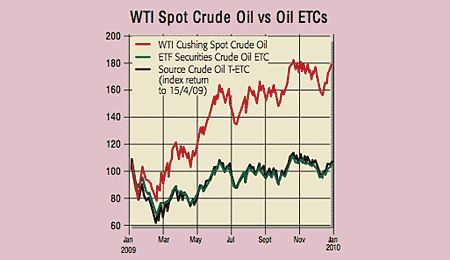Should you buy commodity trackers?
Commodity trackers are the most complex type of exchange-traded product. So if you're thinking of using them, you really need to do your homework.

Commodity trackers are the most complex type of exchange-traded product. That's a bad thing. Complexity always favours the product issuer and works against an uninformed investor. So if you're thinking of using them, you need to do your homework.
Take oil trackers. If you'd predicted a rebound in the price of crude oil from its 2009 low of $31 a barrel, you'd have been spot on. But if you'd bet on it using an oil exchange-traded commodity (ETC), your return would have fallen far short of the oil price's gain because of 'contango'.
Most ETCs track the underlying asset price using futures contracts. When a contract expires, the tracker buys (or 'rolls over') into a longer-dated one. When a market is in contango, it means that the further into the future you go, the higher the price of the relevant contract. So when you swap the expiring shorter-dated contract for a longer-dated one, you incur a cost. This can be very high indeed. The spot oil price went up 78% last year, but ETF Securities' and Source's Crude Oil ETCs gave only single-figure returns (see chart).
MoneyWeek
Subscribe to MoneyWeek today and get your first six magazine issues absolutely FREE

Sign up to Money Morning
Don't miss the latest investment and personal finances news, market analysis, plus money-saving tips with our free twice-daily newsletter
Don't miss the latest investment and personal finances news, market analysis, plus money-saving tips with our free twice-daily newsletter

It doesn't always work this way. Backwardation, the opposite to contango, boosted tracker performance during most of the 1990s. But the point is that the futures curve can be far more important to a tracker than the spot price so if you want to bet on commodities using ETCs, you need to take account of this.
There is one area of the commodities market where contango effects are minimal physically backed precious-metals trackers, such as ETF Securities' ETCs which track physical gold, silver, platinum and palladium. So we'd be happy to play the price of gold, for example, with a tracker.
But if you plan to invest in the wider commodities markets, we'd suggest an ETF that aims to minimise the negative impact of contango (and maximise the backwardation benefits): db x-trackers' DBLCI-OY Balanced fund (LSE: XBDB).
The fund does this by choosing futures contracts from along the curve, rather than automatically rolling into the next contract month. It reflects the performance of 14 commodities. It has a 55% weighting in energy, 10% in precious metals, 13% in industrial metals, and the remainder in corn, wheat, soybeans and sugar. The fund is Europe's largest diversified raw materials ETF and has a total expense ratio of 0.55% a year.
Paul Amery is editor of www.indexuniverse.eu .
Get the latest financial news, insights and expert analysis from our award-winning MoneyWeek team, to help you understand what really matters when it comes to your finances.
Paul is a multi-award-winning journalist, currently an editor at New Money Review. He has contributed an array of money titles such as MoneyWeek, Financial Times, Financial News, The Times, Investment and Thomson Reuters. Paul is certified in investment management by CFA UK and he can speak more than five languages including English, French, Russian and Ukrainian. On MoneyWeek, Paul writes about funds such as ETFs and the stock market.
-
 The shape of yields to come
The shape of yields to comeCentral banks are likely to buy up short-term bonds to keep debt costs down for governments
-
 The sad decline of investment clubs – and what comes next
The sad decline of investment clubs – and what comes nextOpinion Financial regulation and rising costs are killing off investment clubs that once used to be an enjoyable hobby, says David Prosser
